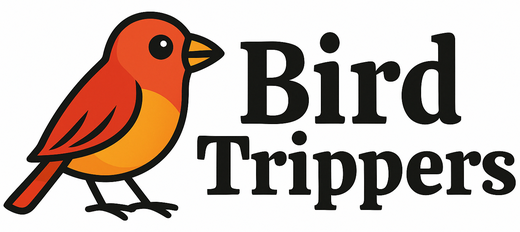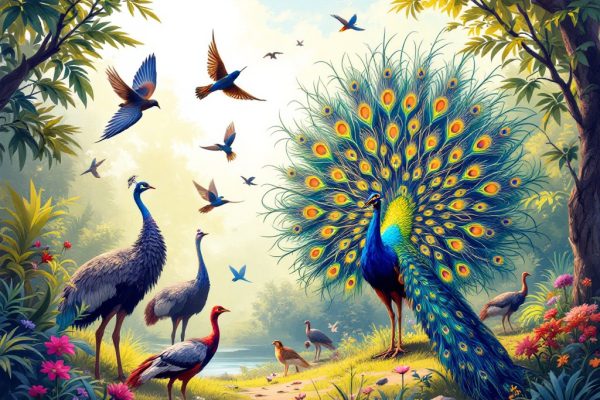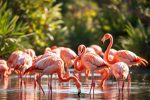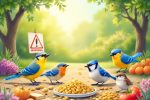List of Red Birds: Have You Already Spotted Them in the Wild
Dazzling red birds, from the familiar Northern Cardinal to the striking Scarlet Tanager, ignite landscapes with their vibrant hues. These colors aren’t just for show; they’re vital for communication, attracting mates, and establishing dominance. Discover the fascinating world of red birds, explore their diverse species, learn how their brilliant plumage is created through diet, and get practical tips for attracting these fiery beauties to your own backyard. Uncover the secrets of these feathered jewels and enhance your birdwatching experience today!
Important information
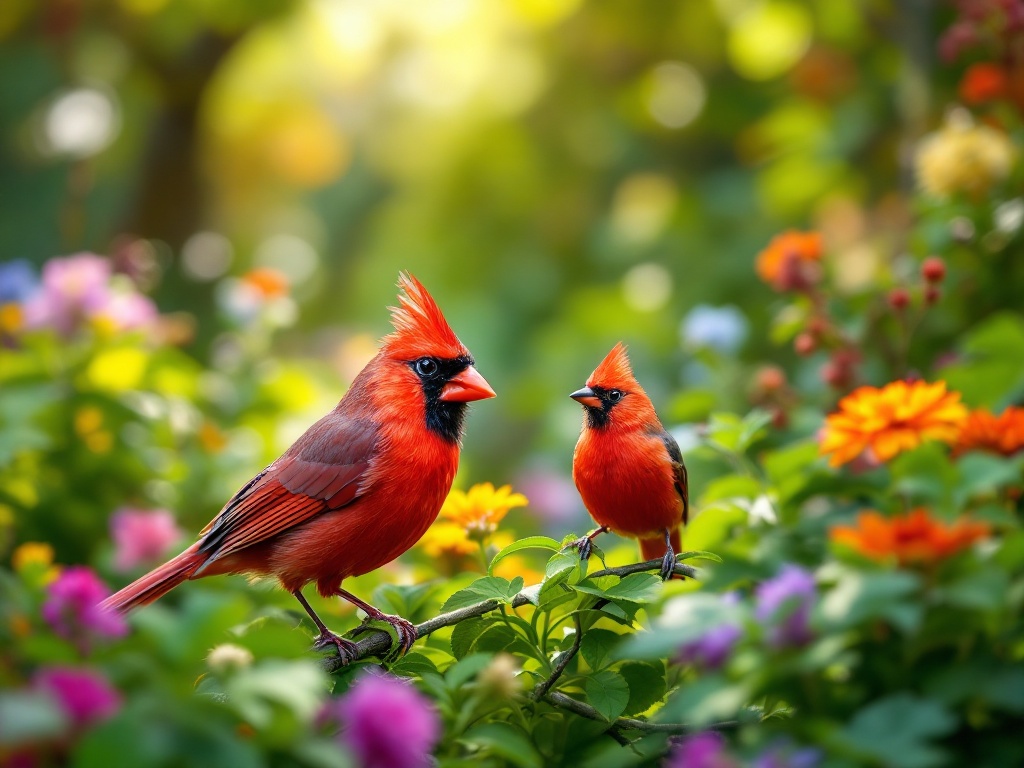
- The vibrant red color of many bird species comes from carotenoids in their diet of insects and fruit.
- Male birds use their red plumage to attract mates and show dominance.
- Many red bird species, like the Northern Cardinal and Scarlet Tanager, can be found in different habitats across North America.
- Birdwatchers can attract red birds to their backyards with feeders containing sunflower seeds, suet, or fruit, and a water source.
- Red birds, like the Scarlet Tanager, often migrate long distances, so understanding migration patterns helps with spotting them.
Introduction to Red Birds: Nature’s Fiery Beauties
Red birds are captivating creatures, their vibrant plumage a striking scarlet against snowy winter landscapes and lush green forests. This brilliance makes them easy to spot, and it also serves a vital purpose: attracting potential mates and warning off rivals in a powerful display.
Characteristics of Red Birds
Red birds fascinate with their diverse shades and patterns of red plumage. These vibrant colors play a crucial role in communication, especially for attracting mates and establishing dominance. The intensity of these red hues often indicates a bird’s health and fitness, a key factor in mate selection. These brilliant colors are derived from carotenoid pigments, obtained through their diet.
Male Summer Tanager
The male Summer Tanager is a brilliant, solid red, a striking display that sets him apart.
Purple Finch
The Purple Finch exhibits a raspberry-red hue on its head, chest, and back.
Red Feathers as Communication Tools
A male bird’s vibrant red plumage serves as a powerful advertisement of his genetic strength and robust health, a crucial factor in attracting potential mates. Females carefully assess this visual cue, selecting partners best suited to father healthy offspring. Consequently, a male’s colorful display significantly boosts his chances of reproductive success.
The Role of Carotenoids in Red Coloration
A bird’s vibrant red plumage comes from carotenoid pigments found in their diet, primarily fruits and insects. These pigments are processed and deposited into the feathers, with the specific types and quantities influencing the resulting shade and brilliance. Remarkably, some birds can even modify the carotenoids they consume to create a variety of red hues. Beyond pigment, feather structure plays a crucial role, affecting light reflection to intensify color vibrancy.
Popular Red Bird Species to Spot in the Wild
Northern Cardinals, known for their vibrant red plumage, are a frequent sight in backyards. Scarlet Tanagers, with their striking red bodies and contrasting black wings, inhabit forests. Summer Tanagers, featuring a cherry-red hue, can be found in open woodlands. Hepatic Tanagers display a more subdued reddish tone. Vermilion Flycatchers, with their vibrant red-orange coloring, are a flash of color as they hunt.
Social Pine Grosbeaks are known for their flocking behavior. Red Crossbills and White-winged Crossbills, equipped with uniquely crossed bills, are adept at extracting seeds from cones. Purple Finches boast a beautiful raspberry-red plumage. Red-headed Woodpeckers are instantly recognizable with their entirely crimson heads. During winter, Common Redpolls, with their distinctive red caps, migrate down from the Arctic.
House Finches, small and red, are common in Florida. Red-bellied Woodpeckers have subtle red markings on their caps and bellies. Rose-breasted Grosbeaks, a striking mix of black and white, are accented by a distinctive red breast. Red-faced Warblers are unique with their red mask-like markings. Pyrrhuloxia, desert dwellers, resemble cardinals.
Western Tanagers display a vibrant blend of red, yellow, and black. These birds bring a splash of color to their respective habitats, from backyards to forests and deserts.
Northern Cardinal: A Backyard Favorite
The male Northern Cardinal is a striking, vibrant red, accented by a pointed crest and a black mask encircling his beak. Females, while a softer reddish-brown, still display flashes of red on their wings, tail, and crest. These birds are year-round residents of the eastern United States, commonly found in backyards, gardens, and woodlands. During winter, they are frequent visitors to bird feeders.
Scarlet Tanager: The Forest Dweller
The medium-sized Scarlet Tanager is a striking songbird. Males are a vibrant red with contrasting black wings and tail, making them easy to identify. Females, however, sport a subtle olive-green plumage with darker wings and tail, providing excellent camouflage amongst the leaves. These birds inhabit the deciduous forests of eastern North America. Their diet consists primarily of insects and berries, such as caterpillars and wild berries. Scarlet Tanagers are migratory birds, spending their winters in the warmer climates of Central and South America.
Summer Tanager: The Cherry-Red Beauty
The striking, all-red Summer Tanager is a unique sight, being North America’s only completely red bird. These vibrant creatures inhabit wooded areas, feasting on a varied diet of insects like bees and wasps, along with fruit. Their impressive aerial skills allow them to snatch bees and wasps mid-flight. Though they often stay concealed high in the treetops, birdwatchers might glimpse these colorful birds visiting backyards in the fall to search for berries.
Hepatic Tanager: The Subtle Red
Male Hepatic Tanagers are a striking reddish-orange, though their wing patches are a more subdued hue.
Females, on the other hand, are yellow, resembling young males.
This species has a wide breeding range, nesting across Mexico, Central America, and the southwestern United States, typically in wooded habitats.
Vermilion Flycatcher: The Agile Hunter
The Vermilion Flycatcher is a skilled aerial hunter, known for snatching insects mid-flight. These brightly plumaged birds perch on fences and low branches, patiently waiting to spot their prey. Their striking red feathers make them easy to identify. Vermilion Flycatchers frequent open areas like parks and grasslands, typically near water sources. Their quick, swooping flight is a characteristic hunting behavior.
Pine Grosbeak: The Gregarious Flocker
The plump, sociable Pine Grosbeak is a large finch known for its gentle nature. Often found in large flocks, the males sport a striking reddish-pink plumage interspersed with gray. Females, by contrast, exhibit a softer, lighter version of this pattern. These birds primarily inhabit the coniferous forests of Canada and the northern United States.
Red Crossbill & White-winged Crossbill: The Adaptive Feeders
Red Crossbills use their uniquely crossed beaks to extract seeds from pine cones. White-winged Crossbills share this distinctive beak structure, but are easily identified by the white markings on their wings. Both species thrive in coniferous forests, demonstrating a remarkable adaptation to this environment’s food sources.
Purple Finch: The Raspberry-Red Songbird
The male Purple Finch is a striking bird with a vibrant raspberry red head and breast.
A key distinction between Purple and House Finches lies in their beaks: the Purple Finch’s is more conical.
Females, in contrast, sport brown, streaked plumage.
These birds primarily dine on seeds, buds, and fruits.
Come winter, they migrate from their forest homes to diverse habitats, sometimes venturing as far south as northern Florida.
Red-Headed Woodpecker: The Striking Head Turner
The Red-headed Woodpecker is a striking bird with an unforgettable bright red head, neck, and throat. Its black back and wings contrast sharply with its white chest and belly, making identification easy. This bold woodpecker hunts insects mid-flight, but also enjoys nuts, fruits, and seeds. A year-round resident of Florida, it prefers open woodlands and grasslands.
Common Redpoll: The Arctic Visitor
The common redpoll (Acanthis flammea) is a small finch that breeds in the Arctic. During winter, these birds may irrupt, flying south in large flocks. Males sport a distinctive red cap and breast. Well-adapted to cold climates, redpolls burrow into the snow for warmth and are frequent visitors to bird feeders.
House Finch: The Little Red Bird of Florida
House Finches are small birds commonly found across the United States and Mexico, including northern Florida. Adult males are easily recognized by their vibrant red plumage on the face and chest. Females, on the other hand, have streaky brown feathers. These lively birds are frequent visitors to backyard feeders, especially drawn to sunflower seeds. Their diet mainly consists of seeds, fruits, and buds.
Red-bellied Woodpecker: The Misleading Name
The Red-bellied Woodpecker’s name is misleading: the most prominent red marking is on its head, not its belly, which has only a slight reddish tint. These birds flourish throughout the eastern United States, including Florida, inhabiting forests, wetlands, and even suburban backyards. Their diet is diverse, consisting of insects, fruits, nuts, and seeds.
Rose-breasted Grosbeak: The Black and White Singer
The male Rose-breasted Grosbeak is a striking beauty with a jet-black head and a vibrant red breast, accented by distinctive white wing patches. Females and immature males, however, sport brown streaks. These forest-dwelling birds breed across eastern and central U.S. and Canada, migrating south to Central and South America for the winter. Floridians can glimpse these colorful migrants during their spring and fall journeys, often near water sources.
Red-Faced Warbler: The Masked Beauty
The Red-faced Warbler is a striking bird, easily identified by its bright red face mask contrasted against a black crescent on its head. Its soft gray belly and dark gray wings add to its distinctive appearance. This warbler inhabits high-elevation, mature forests across Arizona, New Mexico, and Mexico. However, it migrates to tropical regions from mid-September to April, returning to the U.S. to breed. During the breeding season, these birds forage high in the trees. Logging poses a significant threat, destroying the forests essential to their survival.
Pyrrhuloxia: The Desert Cardinal
The striking Pyrrhuloxia, nicknamed the “desert cardinal,” flashes red markings on its face, wings, and belly. This social bird thrives in arid landscapes and frequents southwestern U.S. yards, especially during warmer weather when food sources like sunflower seeds are abundant at feeders. Its natural diet also includes berries and seeds gathered from desert shrubs and trees.
Western Tanager: The Mixed Palette
The Western Tanager is a strikingly colorful bird, boasting a vibrant red-orange head and bright yellow body. Black wings and back complete its unique and easily identifiable plumage. This bold combination sets it apart from other red birds.
Habitats and Behaviors of Red Birds
Red birds thrive in diverse habitats. Woodlands and forests offer shelter and nesting sites for species like Scarlet Tanagers and Red-headed Woodpeckers. Grasslands and open fields serve as hunting grounds for insect-eating birds such as the Vermilion Flycatcher. Wetlands and marshes attract birds like the Summer Tanager, which feeds on aquatic life. Urban areas, including backyards and parks, provide habitats for adaptable species like Northern Cardinals and House Finches. Each environment supports a unique community of these colorful birds.
Woodlands and Forests: Home to Many
Woodlands and forests are vibrant habitats for various colorful bird species, including:
- Scarlet tanager,
- Hepatic tanager,
- Pine grosbeak.
Different forest types support specific species:
- Red-faced warbler can be spotted in the higher mountain forests,
- Coniferous forests shelter both red and white-winged crossbills,
- Red-bellied woodpeckers and rose-breasted grosbeaks thrive in the woodlands.
The health of these wooded environments is crucial for the survival of all these diverse species.
Grasslands and Open Fields: The Hunting Grounds
Several red bird species thrive in grasslands and open fields, taking advantage of the clear sightlines to hunt. Insects and rodents are frequent prey. The Vermilion Flycatcher, for instance, uses impressive aerial maneuvers to snatch insects mid-flight.
- Northern Cardinal often spotted in backyards, forages for seeds and insects in grasslands.
- Red-headed Woodpecker hunts insects there, storing its finds in tree crevices.
Pyrrhuloxia, a desert cardinal, seeks seeds and insects among the open desert scrub, a type of grassland habitat.
- Western Tanager frequents these areas, hunting for insects.
Wetlands and Marshes: The Water Lovers
Wetland habitats support several red bird species. The Swamp Sparrow, known for its reddish-brown feathers, thrives in marshes. The Red-winged Blackbird, with its bright red and yellow shoulder patches, is another common wetland resident. Other red bird species also utilize these habitats.
Backyards and Parks: Urban Adaptations
Urban environments surprisingly suit certain red birds like Northern Cardinals and House Finches. These species thrive in backyards and parks, utilizing feeders and nesting in available trees and shrubs.
Their adaptability is key to this urban success, particularly their flexible diet and tolerance of human activity. Cardinals, for instance, readily supplement their natural food with seeds from bird feeders.
Their nesting habits have adapted to include urban structures, demonstrating a resourcefulness that allows them to flourish in our evolving world.
Birdwatching Tips for Spotting Red Birds
Attract vibrant red birds to your backyard with these simple steps:
Use bird guides. Bird guides offer detailed descriptions and images, making red bird identification easy.
Learn about bird migration. Understanding migration patterns helps you anticipate when specific red birds will arrive in your area.
Set up bird feeders. Fill feeders with sunflower seeds, suet, or fruit to attract red birds like Northern Cardinals, Summer Tanagers, and Purple Finches.
Provide a water source. A readily available water source encourages red birds to visit and stay in your yard.
Using Bird Identification Guides
Bird identification guides are invaluable tools offering detailed descriptions and illustrations to help differentiate similar species. Many guides organize birds by color, making it easy to narrow down possibilities if you spot a red bird, for example. However, for accurate identification, also consider beak shape and size, as well as habitat cues within the guide.
Understanding Bird Migration Patterns
Bird migration is a remarkable journey of survival, as birds cover vast distances to find food and ideal breeding grounds. Their timing and routes are intricately linked to weather patterns and the availability of sustenance. For instance, the Scarlet Tanager breeds in North America but spends its winters in South America, following a migration corridor of berry-rich forests that provides a consistent food source.
Setting Up a Backyard Bird Feeder
Attract vibrant red birds to your backyard by creating a welcoming habitat. Providing a variety of food sources is key. Offer sunflower seeds, suet, and nectar to cater to different preferences. Native plants are essential for shelter and nesting. A birdbath provides a reliable water source. With these elements in place, you’ll enjoy the beauty and songs of red birds like Northern Cardinals and House Finches.
